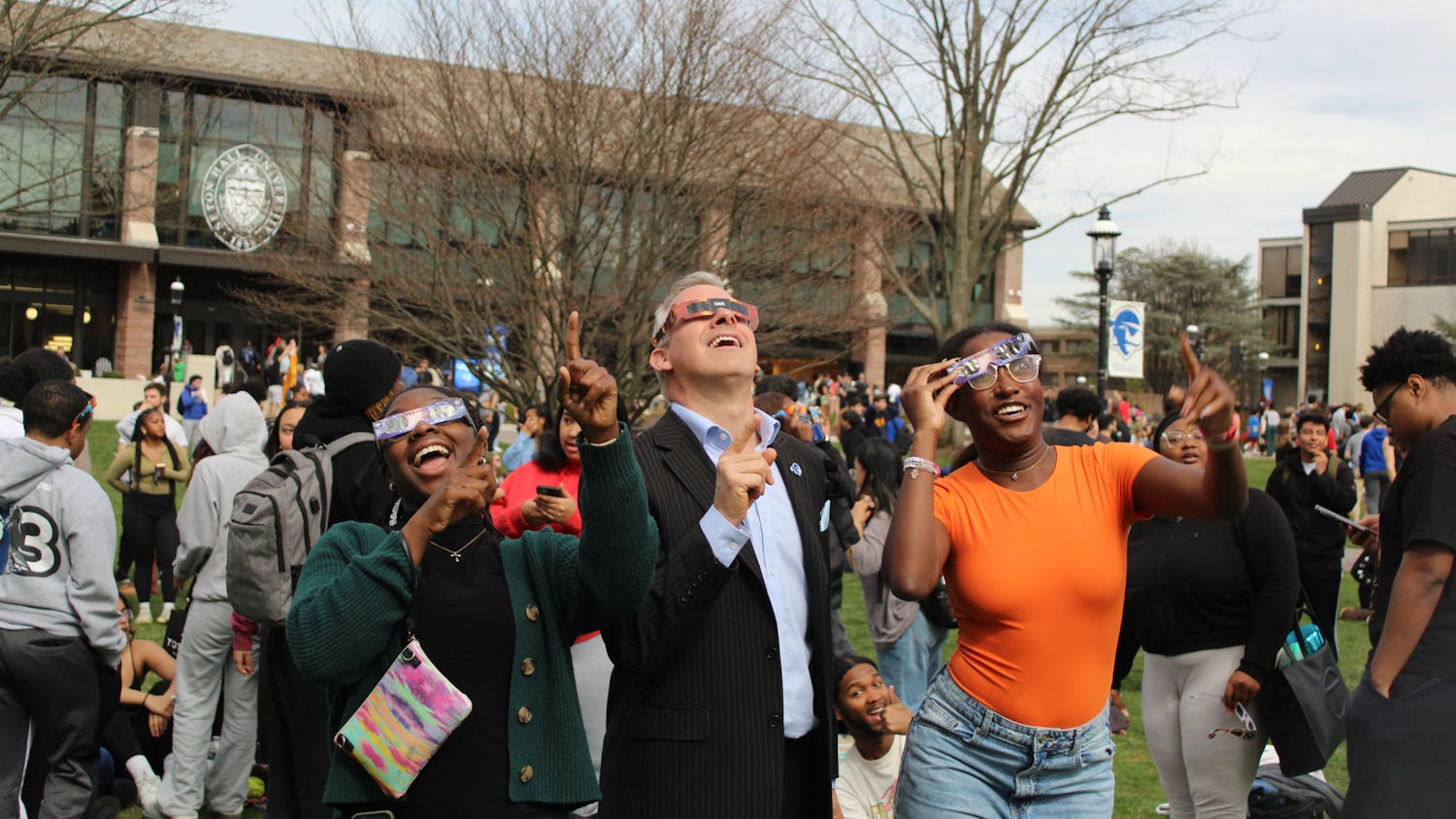[caption id="" align="alignnone" width="250"] shu.edu[/caption]
Seton Hall’s School of Health and Medical Sciences (SHMS) and College of Nursing could soon experience much needed growth to their schools as they “continue to explore the feasibility” of co-locating to the new satellite campus, located in Nutley and Clifton, N.J., according to SHMS Dean Brian Shulman.
What this means is that when the newest SHU campus is fully operational, a goal for the fall of 2017, the nursing school is set to move its graduate programs and the upper-level portion of the undergraduate program to the new campus, while SHMS is set to move its entire program. They will join the state’s newest School of Medicine on the site.
Dr. Shulman said that “co-locating” is the best word to describe the transition because each school will maintain its individual identity equally on the new “branch campus.”
“We’re not going to change the way in which these schools are organized. We’re all going to be under the same roof, so we’re all going to have an inter-professional context and it’s really just not the medical school, you know, this is a new addition to our University structure,” he said.
Dr. Shulman and College of Nursing Dean Marie Foley have pointed to a shortage of space for their programs on South Orange’s campus.
“We’re in dire need of more space,” Dr. Foley said.
One example of how the College could use more space is in utilizing an integral training resource called a simulation lab. The optimal way to conduct these learning labs, with one small group of students caring for a patient in a particular situation and another group watching in a ‘debriefing’ room, is not possible with the limited space solely delegated to the nursing school.
Though nursing students take classes in many buildings around campus, there are only six nursing-designed classrooms in the Caroline Schwartz College of Nursing building, connected to the Arts and Sciences building. The second floor of this building holds Nursing’s administrative offices.
Similarly, SMHS classes are held all over campus and the administrative offices are located on the second floor of McQuaid Hall.
Both schools see the co-location as an opportunity for growth, both in number of programs and enrollment. Dr. Shulman projected that the new campus could hold more than 2,000 students on any given day.
“One of the goals is to grow (SMHS) by 30 percent of its current programs,” Dr. Shulman said, mentioning the addition of a Masters in Public Health and other degree and certificate programs. As of fall 2015, there are around 700 students enrolled in SHMS programs.
Dr. Foley said enrollment has remained relatively constant for the past several years—approximately 900 undergraduate students and about 250 graduate students—despite the implementing higher standards in enrollment criteria.
Dr. Foley said that the College of Nursing “raised the bar,” referencing changes in the last couple years.
The College raised the minimum required GPA, raised the minimum required grades in high school sciences courses and, for transfer students, only science credits from four-year universities are accepted, while those from community colleges will no longer be accepted.
Currently under conditional accreditation with the American Association of Colleges of Nursing, Dr. Foley said that since her start as acting Dean in the summer 2014, the College has put in a lot of support to drop this status.
“What we’ve done is: we’ve changed the curriculum, we made sure that all of the content areas in the NCLEX are on our curriculum, and we have increased our admissions criteria, we increased our progression criteria, we have the assistant dean for student success, we have supplemental instruction and tutoring in many of the nursing courses, we do an NCLEX boot-camp to show students how to study,” she said.
Professor Elizabeth Hoehn is the assistant dean for Student Success, a role that advises students, gives academic coaching and resource referral along with other services to help nursing students navigate and succeed in the curriculum.
The NCLEX is the National Council Licensure Examination, a uniform licensing exam for nurses administered across the country. College of Nursing scores were too low in the years preceding Dr. Foley becoming the dean, prompting the conditional status. The testing periods occur quarterly and within this period, student scores have already improved, Foley said, so she confidently projects the ‘conditional’ will be dropped in September.
A new nursing curriculum was implemented in fall 2015 as well.
Emily Kincaid, a junior nursing major, said that this curriculum change makes much more sense.
“By switching some classes around, the schedule of classes and when to take them flows much better and correlates to the student's knowledge level and experience,” she said.
More changes to the curriculum of SHMS and the College will come with the co-location to implement interprofessional education, what Dr. Shulman calls the “future of healthcare.”
“By co-locating the Seton Hall-Hackensack School of Medicine, with the School of Health and Medical Sciences (SMHS) and College of Nursing, we are going to try to create some portions of our curricula in which all students will be together and learning about each other’s professions and how to care for a patient, and impact the care of the patient,” Dr. Shulman said.
Interprofessional education “occurs when learners of two or more health and/or social care professions engage in learning with, from and about each other to improve collaboration and the delivery of care,” according to the Institute of Medicine.
This motivation to implement interprofessional education has been driven more by the Institute of Health, as opposed to regional competitors, according to the deans.
“Most of the programs in the area, while they might be doing some type of interprofessional education, it's usually just a project or something like that,” Dr. Foley said. For example, Rutgers University hosts events on interprofessional health and Rowan University has lecture series.
Seton Hall currently has the Department of Interprofessional Health Sciences and Health Administration, created 15 years ago, with about 230 students in one of the six departments within SHMS. Originally named the Graduate Programs in Health Sciences, it changed one year
ago to reflect its functional purpose, according to department chair Dr. Terrence Cahill.
Soon, the University will have its own campus operating around this approach.
The University and Hackensack have been collaborating with architectural firm CO/FX, and faculty and student user groups from SHMS and the College of Nursing to plan the new “state-of-the-art” facilities.
This move comes at a time when New Jersey is facing a future shortage of health care professionals alongside an aging population, according to the U.S. Bureau of Labor Statistics.
Emily Balan can be reached at emily.balan@student.shu.edu
shu.edu[/caption]
Seton Hall’s School of Health and Medical Sciences (SHMS) and College of Nursing could soon experience much needed growth to their schools as they “continue to explore the feasibility” of co-locating to the new satellite campus, located in Nutley and Clifton, N.J., according to SHMS Dean Brian Shulman.
What this means is that when the newest SHU campus is fully operational, a goal for the fall of 2017, the nursing school is set to move its graduate programs and the upper-level portion of the undergraduate program to the new campus, while SHMS is set to move its entire program. They will join the state’s newest School of Medicine on the site.
Dr. Shulman said that “co-locating” is the best word to describe the transition because each school will maintain its individual identity equally on the new “branch campus.”
“We’re not going to change the way in which these schools are organized. We’re all going to be under the same roof, so we’re all going to have an inter-professional context and it’s really just not the medical school, you know, this is a new addition to our University structure,” he said.
Dr. Shulman and College of Nursing Dean Marie Foley have pointed to a shortage of space for their programs on South Orange’s campus.
“We’re in dire need of more space,” Dr. Foley said.
One example of how the College could use more space is in utilizing an integral training resource called a simulation lab. The optimal way to conduct these learning labs, with one small group of students caring for a patient in a particular situation and another group watching in a ‘debriefing’ room, is not possible with the limited space solely delegated to the nursing school.
Though nursing students take classes in many buildings around campus, there are only six nursing-designed classrooms in the Caroline Schwartz College of Nursing building, connected to the Arts and Sciences building. The second floor of this building holds Nursing’s administrative offices.
Similarly, SMHS classes are held all over campus and the administrative offices are located on the second floor of McQuaid Hall.
Both schools see the co-location as an opportunity for growth, both in number of programs and enrollment. Dr. Shulman projected that the new campus could hold more than 2,000 students on any given day.
“One of the goals is to grow (SMHS) by 30 percent of its current programs,” Dr. Shulman said, mentioning the addition of a Masters in Public Health and other degree and certificate programs. As of fall 2015, there are around 700 students enrolled in SHMS programs.
Dr. Foley said enrollment has remained relatively constant for the past several years—approximately 900 undergraduate students and about 250 graduate students—despite the implementing higher standards in enrollment criteria.
Dr. Foley said that the College of Nursing “raised the bar,” referencing changes in the last couple years.
The College raised the minimum required GPA, raised the minimum required grades in high school sciences courses and, for transfer students, only science credits from four-year universities are accepted, while those from community colleges will no longer be accepted.
Currently under conditional accreditation with the American Association of Colleges of Nursing, Dr. Foley said that since her start as acting Dean in the summer 2014, the College has put in a lot of support to drop this status.
“What we’ve done is: we’ve changed the curriculum, we made sure that all of the content areas in the NCLEX are on our curriculum, and we have increased our admissions criteria, we increased our progression criteria, we have the assistant dean for student success, we have supplemental instruction and tutoring in many of the nursing courses, we do an NCLEX boot-camp to show students how to study,” she said.
Professor Elizabeth Hoehn is the assistant dean for Student Success, a role that advises students, gives academic coaching and resource referral along with other services to help nursing students navigate and succeed in the curriculum.
The NCLEX is the National Council Licensure Examination, a uniform licensing exam for nurses administered across the country. College of Nursing scores were too low in the years preceding Dr. Foley becoming the dean, prompting the conditional status. The testing periods occur quarterly and within this period, student scores have already improved, Foley said, so she confidently projects the ‘conditional’ will be dropped in September.
A new nursing curriculum was implemented in fall 2015 as well.
Emily Kincaid, a junior nursing major, said that this curriculum change makes much more sense.
“By switching some classes around, the schedule of classes and when to take them flows much better and correlates to the student's knowledge level and experience,” she said.
More changes to the curriculum of SHMS and the College will come with the co-location to implement interprofessional education, what Dr. Shulman calls the “future of healthcare.”
“By co-locating the Seton Hall-Hackensack School of Medicine, with the School of Health and Medical Sciences (SMHS) and College of Nursing, we are going to try to create some portions of our curricula in which all students will be together and learning about each other’s professions and how to care for a patient, and impact the care of the patient,” Dr. Shulman said.
Interprofessional education “occurs when learners of two or more health and/or social care professions engage in learning with, from and about each other to improve collaboration and the delivery of care,” according to the Institute of Medicine.
This motivation to implement interprofessional education has been driven more by the Institute of Health, as opposed to regional competitors, according to the deans.
“Most of the programs in the area, while they might be doing some type of interprofessional education, it's usually just a project or something like that,” Dr. Foley said. For example, Rutgers University hosts events on interprofessional health and Rowan University has lecture series.
Seton Hall currently has the Department of Interprofessional Health Sciences and Health Administration, created 15 years ago, with about 230 students in one of the six departments within SHMS. Originally named the Graduate Programs in Health Sciences, it changed one year
ago to reflect its functional purpose, according to department chair Dr. Terrence Cahill.
Soon, the University will have its own campus operating around this approach.
The University and Hackensack have been collaborating with architectural firm CO/FX, and faculty and student user groups from SHMS and the College of Nursing to plan the new “state-of-the-art” facilities.
This move comes at a time when New Jersey is facing a future shortage of health care professionals alongside an aging population, according to the U.S. Bureau of Labor Statistics.
Emily Balan can be reached at emily.balan@student.shu.edu

Comments




